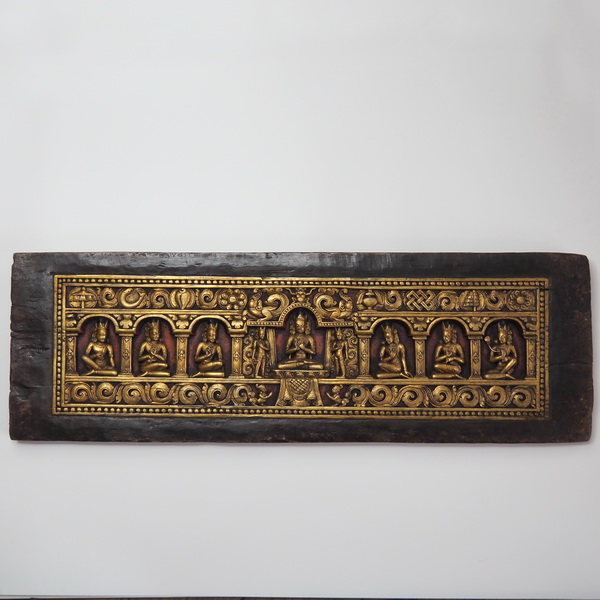Manuscript cover with Vairochana and six Bodhisattvas
See it in the Museum

Aisle
Orientation 2
Wall object 4

ABM 010
Code: ABM 010
Country: Tibet (central)
Style:
Date: 1200 - 1300
Dimensions in cm WxHxD: 62.5 x 21
Materials: Wood
Wood, carved in low relief on the outer side.
Manuscript cover (Skt. pustakakastha/ Tib. gleg shing) depicting from left to right:
....
....
....
Vairocana (Tib. rNam par snang mdzad)
....
....
....
Manuscript cover (Skt. pustakakastha/ Tib. gleg shing) depicting from left to right:
....
....
....
Vairocana (Tib. rNam par snang mdzad)
....
....
....
Vairochana (Nampar Nangdze)
Signification: "Resplendent" (literally: "Lightmaker") - Color: WhiteVairochana is represented here under the aspect of the Sambhogakaya. His hands, which hold the wheel, symbol of the Buddha family over which he presides, form the mudra of meditation instead of the mudra of teaching that usually characterizes him. He occupies the centre in the mandala of the 5 victorious buddhas (his place and that of Akshobya are sometimes reversed).Vairochana represents, at the level of the purity of enlightenment, that which for ordinary beings appears as the first of the aggregation of forms, that is, the material components of manifestation, more particularly the bodies of individuals. It should be recalled that the five aggregates (skandha) are a way of describing the psychophysical faculties governing the functioning of individuals within the framework of the duality of samsara. They therefore no longer exist when the Awakening is reached; the energy which gave rise to their existence, radiates in its purity and in its freedom in the form of the 5 victorious buddhas.Vairochana is also the expression of the wisdom of the dharmadatou. The dharmadatou is the space of the ultimate nature of all phenomena. The wisdom of the dharmadatou means that phenomena, beyond all concepts and duality, remain in the pure knowledge of the mind. The wisdom of the dharmadatou also underlines the essential unity of the other four wisdoms and, in this sense, corresponds to the very essence Body, the svabhavakaya.The wisdom of the dharmadatou is revealed when the spirit is totally free from ignorance. Vairochana therefore holds in his hands the wheel of the Dharma, which symbolizes the Buddha's teaching leading to the dissipation of ignorance.
The Throne of the Four Absences of Fears
The throne of Vairochana, supported by snow lions, means that the five victorious buddhas possess the "four absences of fear", namely the four foundations of the absence of fear in a Buddha:
- the complete elimination of what must be eliminated, for his own good,
- the fulfilment of all qualities, for his own good,
- the teaching of the path of antidotes, for the good of others,
- the teaching of what must be abandoned, for the good of others.
Signification: "Resplendent" (literally: "Lightmaker") - Color: WhiteVairochana is represented here under the aspect of the Sambhogakaya. His hands, which hold the wheel, symbol of the Buddha family over which he presides, form the mudra of meditation instead of the mudra of teaching that usually characterizes him. He occupies the centre in the mandala of the 5 victorious buddhas (his place and that of Akshobya are sometimes reversed).Vairochana represents, at the level of the purity of enlightenment, that which for ordinary beings appears as the first of the aggregation of forms, that is, the material components of manifestation, more particularly the bodies of individuals. It should be recalled that the five aggregates (skandha) are a way of describing the psychophysical faculties governing the functioning of individuals within the framework of the duality of samsara. They therefore no longer exist when the Awakening is reached; the energy which gave rise to their existence, radiates in its purity and in its freedom in the form of the 5 victorious buddhas.Vairochana is also the expression of the wisdom of the dharmadatou. The dharmadatou is the space of the ultimate nature of all phenomena. The wisdom of the dharmadatou means that phenomena, beyond all concepts and duality, remain in the pure knowledge of the mind. The wisdom of the dharmadatou also underlines the essential unity of the other four wisdoms and, in this sense, corresponds to the very essence Body, the svabhavakaya.The wisdom of the dharmadatou is revealed when the spirit is totally free from ignorance. Vairochana therefore holds in his hands the wheel of the Dharma, which symbolizes the Buddha's teaching leading to the dissipation of ignorance.
The Throne of the Four Absences of Fears
The throne of Vairochana, supported by snow lions, means that the five victorious buddhas possess the "four absences of fear", namely the four foundations of the absence of fear in a Buddha:
- the complete elimination of what must be eliminated, for his own good,
- the fulfilment of all qualities, for his own good,
- the teaching of the path of antidotes, for the good of others,
- the teaching of what must be abandoned, for the good of others.
Grönbold, Günter, 1991. Tibetische Buchdeckel, [Austellengskatalog Bayerische Staatsbibliothek, München]. München: Bayerische Stadtsbibliothek.
Weldon, David, 1996. Early Tibetan Manuscript Covers, 12th–15th Century, [catalogue of the sale exhibition held at Barbara Mathes Gallery, New York, 1996]. London: Anna Maria Rossi & Fabio Rossi Publ..

